Beverage Can Market Size 2025-2029
The beverage can market size is valued to increase by USD 5.92 billion, at a CAGR of 3% from 2024 to 2029. Increased need for metal cans will drive the beverage can market.
Major Market Trends & Insights
- APAC dominated the market and accounted for a 49% growth during the forecast period.
- By Application - Non alcoholic beverages segment was valued at USD 20.41 billion in 2023
- By Material - Aluminum segment accounted for the largest market revenue share in 2023
Market Size & Forecast
- Market Opportunities: USD 28.96 billion
- Market Future Opportunities: USD 5915.60 billion
- CAGR from 2024 to 2029 : 3%
Market Summary
- The market has witnessed significant growth in recent years, driven by the increasing consumer preference for convenient, portable, and sustainable packaging solutions. The global market value for beverage cans reached approximately USD35.3 billion in 2020, a testament to the industry's robustness. Key trends shaping the market include the expanding range of ready-to-drink (RTD) coffee and tea offerings, which have gained immense popularity due to their ease of use and on-the-go convenience. Additionally, the increasing demand for aluminum cans, driven by their lightweight and recyclable nature, is expected to continue fueling market expansion. However, the market faces challenges, such as the anticipated rise in steel prices, which may impact the profitability of can manufacturers.
- Furthermore, the growing competition from alternative packaging formats, like PET bottles and cartons, may put pressure on market players to innovate and differentiate their offerings. Despite these challenges, the market remains a dynamic and evolving industry, with ongoing advancements in technology, design, and sustainability driving its future growth. Companies are investing in research and development to create more eco-friendly and functional cans, ensuring the market's continued relevance and appeal to consumers.
What will be the Size of the Beverage Can Market during the forecast period?
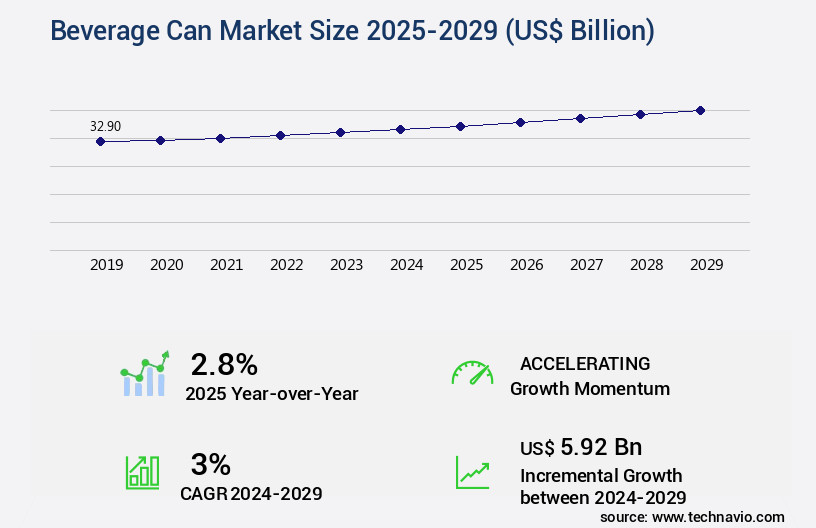
Get Key Insights on Market Forecast (PDF) Request Free Sample
How is the Beverage Can Market Segmented ?
The beverage can industry research report provides comprehensive data (region-wise segment analysis), with forecasts and estimates in "USD billion" for the period 2025-2029, as well as historical data from 2019-2023 for the following segments.
- Application
- Non alcoholic beverages
- Alcoholic beverages
- Material
- Geography
- North America
- Europe
- Middle East and Africa
- APAC
- South America
- Rest of World (ROW)
By Application Insights
The non alcoholic beverages segment is estimated to witness significant growth during the forecast period.
The market continues to evolve, with metal cans dominating the scene due to their hermetic seal and protection against oxygen and sunlight. In 2024, an impressive 75% of UK consumers preferred canned drinks for their superior taste. Driving this trend are rising global temperatures and increasing disposable income. However, health concerns over artificially sweetened beverages pose a challenge. To address this, companies innovate by introducing low-sugar or sugar-free options. The printing process for can design software ensures efficient can production, while advancements in can coating techniques and can closure integrity maintain can quality control. High-speed aluminum can production, using three-piece or two-piece methods, adheres to standard can dimensions.
Aluminum alloy selection, can body making, and can end forming are crucial aspects of aluminum can manufacturing. Can Filling Equipment, can testing procedures, and can manufacturing automation ensure can production line efficiency. Sustainable can packaging, can weight optimization, and pressure testing are essential for reducing waste and maintaining safety standards. The recycling processes for used cans further emphasize their eco-friendliness.
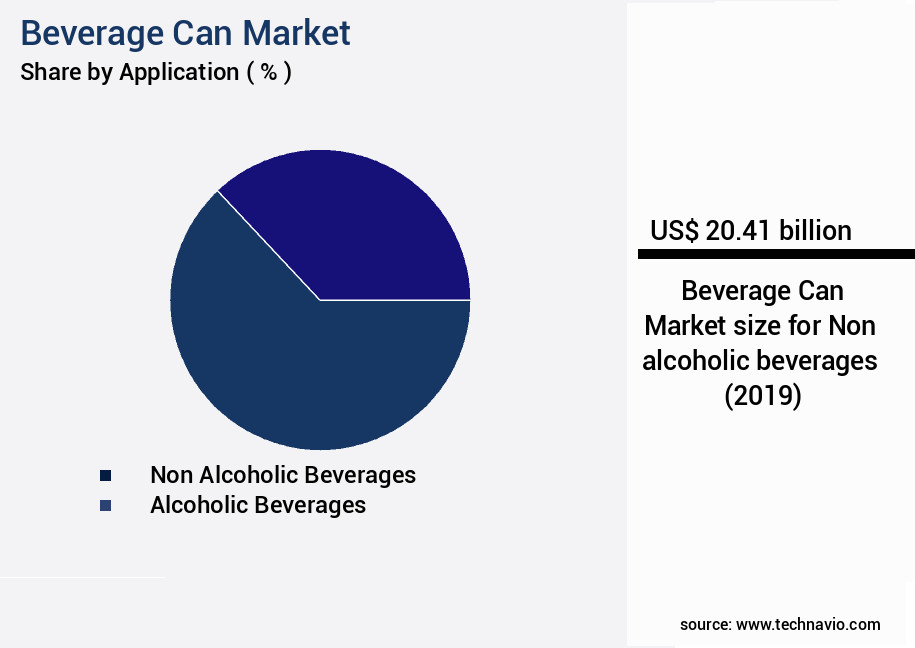
Request Free Sample
The Non alcoholic beverages segment was valued at USD 20.41 billion in 2019 and showed a gradual increase during the forecast period.
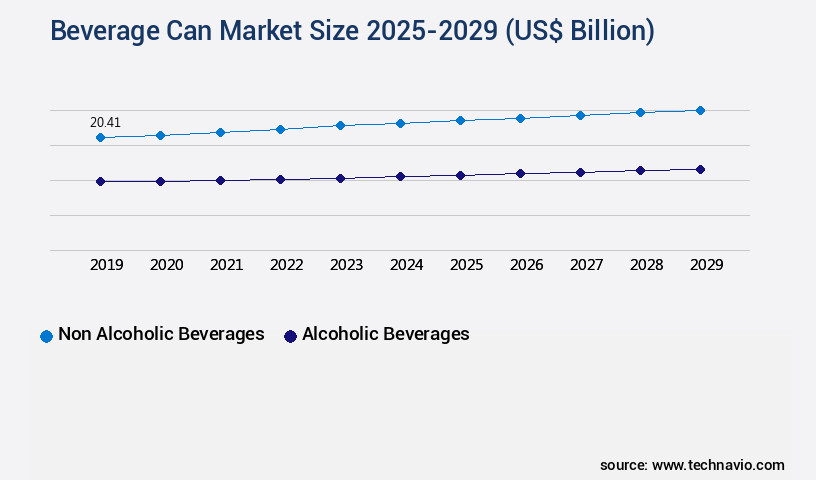
Request Free Sample
Regional Analysis
APAC is estimated to contribute 49% to the growth of the global market during the forecast period.Technavio's analysts have elaborately explained the regional trends and drivers that shape the market during the forecast period.
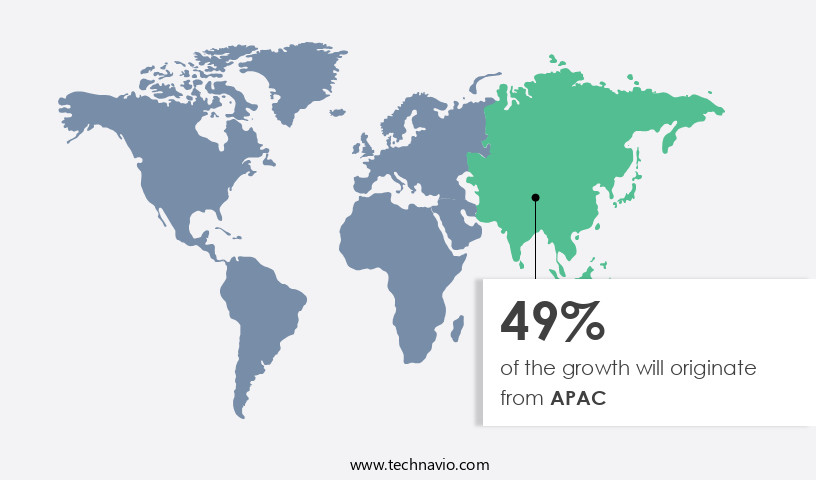
See How Beverage Can Market Demand is Rising in APAC Request Free Sample
The global beer market is experiencing significant growth, particularly in the Asia Pacific (APAC) region. Fueled by the emergence of a burgeoning middle class and the adoption of Western culture in countries like China and India, the demand for beer is on the rise. This trend is further bolstered by the increasing disposable income of the working population, enabling them to afford alcoholic beverages.
Consequently, the number of bars, retail stores, and restaurants serving beer in APAC has proliferated, driving the growth of the beer market. This expansion is expected to translate into increased demand for beverage cans, a popular packaging solution for beer, during the forecast period.
Market Dynamics
Our researchers analyzed the data with 2024 as the base year, along with the key drivers, trends, and challenges. A holistic analysis of drivers will help companies refine their marketing strategies to gain a competitive advantage.
The market is a dynamic and evolving industry that places a significant emphasis on innovation and efficiency. One crucial aspect of can manufacturing is optimizing design for stacking efficiency, ensuring cans fit seamlessly together during transportation and storage. Can design also plays a role in reducing defects in high-speed production lines, with sleeker shapes and smoother edges contributing to improved manufacturing processes. Another essential consideration is the impact of can coating on corrosion resistance, which is crucial for maintaining product quality and extending shelf life. Can manufacturers employ advanced techniques to improve sealing integrity, ensuring cans remain airtight and maintain their contents' freshness. Can material selection is a critical factor in production cost, with aluminum being a popular choice due to its strength, lightweight, and recyclability.
Manufacturers also focus on improving can printing quality using innovative techniques, ensuring branding remains vibrant and clear. Measuring can wall thickness using non-destructive methods and analyzing defects using image processing are essential for maintaining consistent quality and reducing waste. Developing sustainable can recycling procedures is a priority, with a focus on enhancing production line automation and efficiency, improving handling automation, and employing can body fabrication techniques for increased strength. Advanced can testing methods and can end forming techniques for optimal sealing are essential for ensuring product safety and quality. Minimizing can production waste through lean manufacturing practices and can weight reduction without compromising strength are ongoing goals. Effective can sanitation methods are crucial for enhanced safety, and implementing traceability in can production and distribution is a critical component of maintaining transparency and accountability.
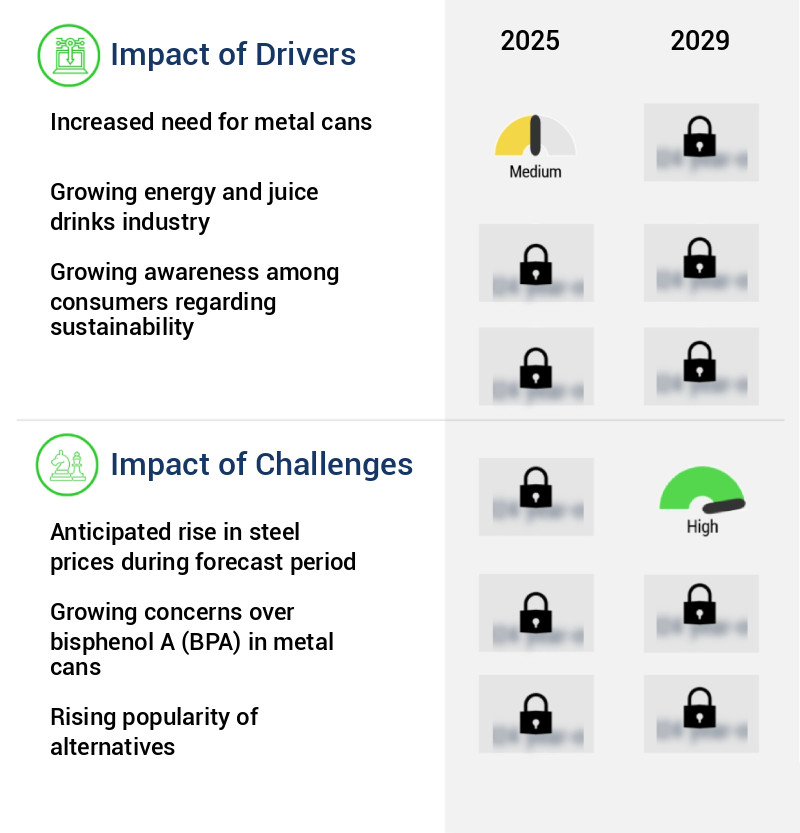
What are the key market drivers leading to the rise in the adoption of Beverage Can Industry?
- The significant rise in consumer demand for metal cans serves as the primary market driver.
- Metal cans have become a preferred choice for various beverage industries, including beer, soft drinks, ready-to-drink tea and coffee, and juices. The primary reason for the expanding adoption of metal cans in the beverage sector is their superior hermetic sealing properties. Metal's inherent sealing capabilities enable metal cans to form airtight seals more effectively than other packaging materials. This attribute is crucial for beverage manufacturers as it ensures product freshness and prevents contamination. Moreover, metal cans offer enhanced durability compared to their glass or plastic counterparts. They are less susceptible to breakage during transportation, making them an ideal option for industries dealing with fast-paced production and distribution processes.
- Additionally, metal cans maintain their structural integrity across a wide range of temperatures. Unlike plastic packaging, which may undergo shape changes when exposed to extreme temperatures, metal can products remain unaffected. In summary, The market continues to grow due to metal cans' hermetic sealing properties, durability, and temperature resistance. These advantages make metal cans a versatile and reliable choice for various beverage industries, enabling them to maintain product quality and efficiency throughout the supply chain.
What are the market trends shaping the Beverage Can Industry?
- The growing market trend reflects the increasing popularity of ready-to-drink (RTD) coffee and tea beverages.
- The RTD coffee and tea market has witnessed significant growth due to their increasing popularity as instant energy drinks and integration into various lifestyles worldwide. Countries like Japan and the United States have seen a notable rise in consumption. Key driving factors include the expanding health consciousness and increasing disposable income levels among populations. The trend of consuming on-the-go health drinks has significantly influenced the demand for RTD coffee and tea.
- Among various packaging types, metal cans dominate the market due to their portability and convenience. The millennial demographic is a significant consumer base, seeking instant energy sources. The RTD tea and coffee market continues to evolve, with ongoing research and development focusing on product innovation and sustainability.
What challenges does the Beverage Can Industry face during its growth?
- The anticipated rise in steel prices during the forecast period poses a significant challenge to the industry's growth trajectory. This trend, which is a key concern for industry professionals, may hinder the industry's expansion and profitability.
- Aluminum and steel are the primary materials used in the production of beverage cans. While aluminum is the main component, it is derived from steel. The cost structure for aluminum and steel can manufacturing is significantly influenced by the price fluctuations of steel. In recent developments, China's decision to reduce steel production has led to an anticipated increase in steel prices.
- This shift was necessitated due to a surge in global trade cases against China for steel dumping, which had previously kept the global market oversupplied, resulting in a 15.18% increase in steel production from September 2021 to September 2022. This trend, in turn, could potentially impact the cost dynamics of aluminum and steel can manufacturing.
Exclusive Technavio Analysis on Customer Landscape
The beverage can market forecasting report includes the adoption lifecycle of the market, covering from the innovator's stage to the laggard's stage. It focuses on adoption rates in different regions based on penetration. Furthermore, the beverage can market report also includes key purchase criteria and drivers of price sensitivity to help companies evaluate and develop their market growth analysis strategies.
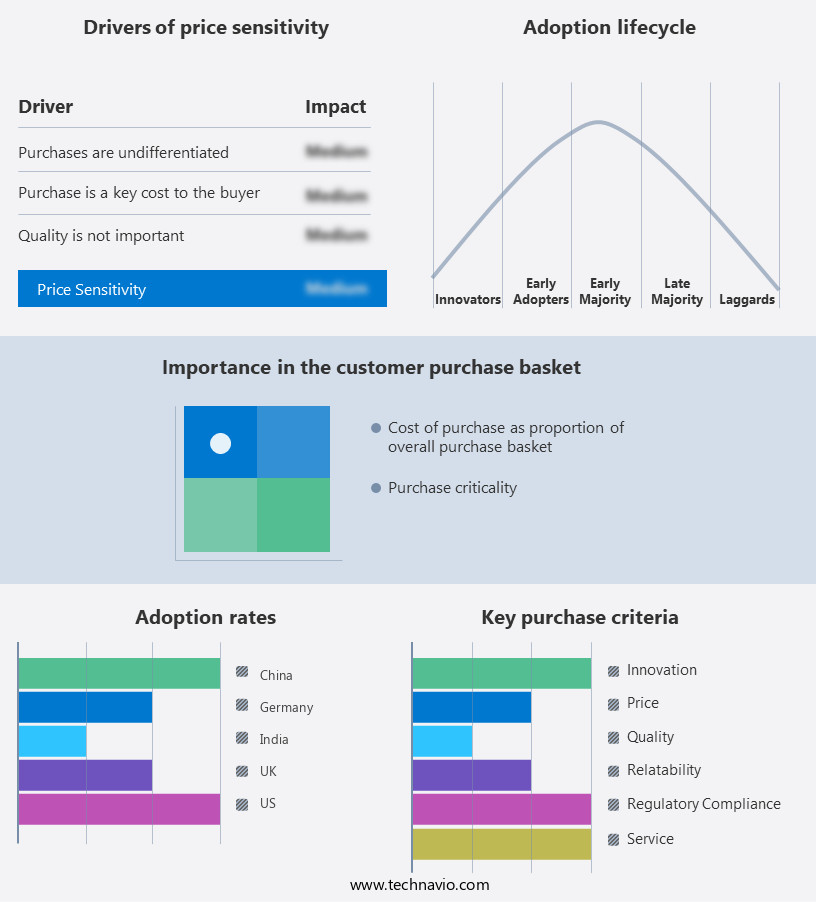
Customer Landscape of Beverage Can Industry
Competitive Landscape
Companies are implementing various strategies, such as strategic alliances, beverage can market forecast, partnerships, mergers and acquisitions, geographical expansion, and product/service launches, to enhance their presence in the industry.
Amcor Plc - The company specializes in innovative beverage container solutions, including the PowerFlex Dome 500ml can, aluminum capsules, and AmPrima PE recycled liquid seal for bottles. These offerings prioritize sustainability and functionality, setting industry standards for Beverage Packaging.
The industry research and growth report includes detailed analyses of the competitive landscape of the market and information about key companies, including:
- Amcor Plc
- Ardagh Group SA
- Ball Corp.
- Bangkok Can Manufacturing Co. Ltd.
- Can One Berhad
- CANPACK SA
- CPMC Holdings Ltd.
- Crown Holdings Inc.
- Envases Ohringen GmbH
- GZ Industries Ltd.
- Kian Joo Can Factory Bhd
- Mahmood Saeed Co. Ltd.
- Mitsubishi Materials Corp.
- Nampak Ltd.
- ORG Technology Co. Ltd.
- Orora Ltd.
- Shengxing Group
- Silgan Holdings Inc.
- Toyo Seikan Group Holdings Ltd.
- Trivium Packaging BV
Qualitative and quantitative analysis of companies has been conducted to help clients understand the wider business environment as well as the strengths and weaknesses of key industry players. Data is qualitatively analyzed to categorize companies as pure play, category-focused, industry-focused, and diversified; it is quantitatively analyzed to categorize companies as dominant, leading, strong, tentative, and weak.
Recent Development and News in Beverage Can Market
- In January 2024, Ball Corporation, a leading beverage can manufacturer, announced the acquisition of Rexam PLC's beverage can business for approximately USD3.9 billion. This strategic move expanded Ball's global reach and increased its market share in Europe (Reuters, 2024).
- In March 2024, PepsiCo and Nestlé entered into a partnership to develop and commercialize a 100% recycled PET (rPET) beverage can. This collaboration aimed to reduce the environmental impact of their beverage packaging and increase the use of recycled materials (Bloomberg, 2024).
- In May 2024, Ardagh metal packaging, a leading international supplier of metal and Glass Packaging, invested €150 million in its European beverage can manufacturing facilities. This significant investment was aimed at increasing capacity and improving efficiency to meet growing demand (Ardagh Metal Packaging Press Release, 2024).
- In January 2025, Coca-Cola European Partners (CCEP) received regulatory approval for its acquisition of the Suntory Beverage & Food Europe business from Suntory Holdings. This acquisition expanded CCEP's product portfolio and market presence in Europe (Coca-Cola European Partners Press Release, 2025).
Dive into Technavio's robust research methodology, blending expert interviews, extensive data synthesis, and validated models for unparalleled Beverage Can Market insights. See full methodology.
|
Market Scope
|
|
Report Coverage
|
Details
|
|
Page number
|
196
|
|
Base year
|
2024
|
|
Historic period
|
2019-2023 |
|
Forecast period
|
2025-2029
|
|
Growth momentum & CAGR
|
Accelerate at a CAGR of 3%
|
|
Market growth 2025-2029
|
USD 5.92 billion
|
|
Market structure
|
Fragmented
|
|
YoY growth 2024-2025(%)
|
2.8
|
|
Key countries
|
US, China, Canada, Germany, India, Japan, Brazil, UK, France, and UAE
|
|
Competitive landscape
|
Leading Companies, Market Positioning of Companies, Competitive Strategies, and Industry Risks
|
Request Free Sample
Research Analyst Overview
- The market continues to evolve, with advancements in technology and consumer preferences driving innovation across various sectors. The printing process for can design has seen significant improvements, enabling more intricate and vibrant graphics. Can production efficiency has been enhanced through automation and high-speed processes, such as aluminum can manufacturing, which can produce up to 1,000 cans per minute. Can decoration processes have expanded to include coating techniques, allowing for matte, glossy, and textured finishes. Can durability testing ensures product safety and longevity, while can filling equipment guarantees consistent product quality. Can closure integrity is maintained through rigorous testing procedures and quality control measures.
- Can stacking efficiency and production cost savings are crucial considerations in the industry, with sustainable can packaging and weight optimization becoming increasingly important. The market is expected to grow by 3.5% annually, driven by consumer demand for convenient and eco-friendly packaging solutions. For instance, a leading beverage company increased sales by 15% by implementing a three-piece can production line, which offers greater design flexibility and improved can body fabrication. Can manufacturing automation, including can end forming and end production, has streamlined production lines and reduced waste. Aluminum alloy selection, can body making, and two-piece can production methods also play significant roles in the market.
- Can sealing methods continue to evolve, with new technologies ensuring leak detection and pressure testing for optimal product safety. Sustainability remains a key focus, with aluminum cans being 100% recyclable and the most recycled beverage container in the world. The industry continues to innovate, with ongoing research and development in can recycling processes and safety standards.
What are the Key Data Covered in this Beverage Can Market Research and Growth Report?
-
What is the expected growth of the Beverage Can Market between 2025 and 2029?
-
What segmentation does the market report cover?
-
The report is segmented by Application (Non alcoholic beverages and Alcoholic beverages), Material (Aluminum and Steel), and Geography (APAC, North America, Europe, Middle East and Africa, and South America)
-
Which regions are analyzed in the report?
-
APAC, North America, Europe, Middle East and Africa, and South America
-
What are the key growth drivers and market challenges?
-
Who are the major players in the Beverage Can Market?
-
Amcor Plc, Ardagh Group SA, Ball Corp., Bangkok Can Manufacturing Co. Ltd., Can One Berhad, CANPACK SA, CPMC Holdings Ltd., Crown Holdings Inc., Envases Ohringen GmbH, GZ Industries Ltd., Kian Joo Can Factory Bhd, Mahmood Saeed Co. Ltd., Mitsubishi Materials Corp., Nampak Ltd., ORG Technology Co. Ltd., Orora Ltd., Shengxing Group, Silgan Holdings Inc., Toyo Seikan Group Holdings Ltd., and Trivium Packaging BV
Market Research Insights
- The market for beverage cans is a dynamic and ever-evolving industry, with continuous advancements in design, production, and logistics. Two significant data points illustrate this progression. First, the global beverage can recycling rate has reached over 65%, demonstrating the industry's commitment to sustainability and waste reduction. Second, the industry anticipates a growth rate of approximately 4% annually over the next decade, driven by increasing consumer demand for convenient, portable, and eco-friendly packaging solutions.
- For instance, a leading beverage company experienced a 7% sales increase by introducing a new line of aluminum cans with improved design and functionality.
We can help! Our analysts can customize this beverage can market research report to meet your requirements.
Get in touch
1 Executive Summary
- 1.1 Market overview
- Executive Summary - Chart on Market Overview
- Executive Summary - Data Table on Market Overview
- Executive Summary - Chart on Global Market Characteristics
- Executive Summary - Chart on Market by Geography
- Executive Summary - Chart on Market Segmentation by Application
- Executive Summary - Chart on Market Segmentation by Material
- Executive Summary - Chart on Incremental Growth
- Executive Summary - Data Table on Incremental Growth
- Executive Summary - Chart on Company Market Positioning
2 Technavio Analysis
- 2.1 Analysis of price sensitivity, lifecycle, customer purchase basket, adoption rates, and purchase criteria
- Analysis of price sensitivity, lifecycle, customer purchase basket, adoption rates, and purchase criteria
- 2.2 Criticality of inputs and Factors of differentiation
- Overview on criticality of inputs and factors of differentiation
- 2.3 Factors of disruption
- Overview on factors of disruption
- 2.4 Impact of drivers and challenges
- Impact of drivers and challenges in 2024 and 2029
3 Market Landscape
- 3.1 Market ecosystem
- Parent Market
- Data Table on - Parent Market
- 3.2 Market characteristics
- Market characteristics analysis
4 Market Sizing
- 4.1 Market definition
- Offerings of companies included in the market definition
- 4.2 Market segment analysis
- 4.4 Market outlook: Forecast for 2024-2029
- Chart on Global - Market size and forecast 2024-2029 ($ million)
- Data Table on Global - Market size and forecast 2024-2029 ($ million)
- Chart on Global Market: Year-over-year growth 2024-2029 (%)
- Data Table on Global Market: Year-over-year growth 2024-2029 (%)
5 Historic Market Size
- 5.1 Global Beverage Can Market 2019 - 2023
- Historic Market Size - Data Table on Global Beverage Can Market 2019 - 2023 ($ million)
- 5.2 Application segment analysis 2019 - 2023
- Historic Market Size - Application Segment 2019 - 2023 ($ million)
- 5.3 Material segment analysis 2019 - 2023
- Historic Market Size - Material Segment 2019 - 2023 ($ million)
- 5.4 Geography segment analysis 2019 - 2023
- Historic Market Size - Geography Segment 2019 - 2023 ($ million)
- 5.5 Country segment analysis 2019 - 2023
- Historic Market Size - Country Segment 2019 - 2023 ($ million)
6 Qualitative Analysis
- 6.1 The AI impact on Global Beverage Can Market
7 Five Forces Analysis
- 7.1 Five forces summary
- Five forces analysis - Comparison between 2024 and 2029
- 7.2 Bargaining power of buyers
- Bargaining power of buyers - Impact of key factors 2024 and 2029
- 7.3 Bargaining power of suppliers
- Bargaining power of suppliers - Impact of key factors in 2024 and 2029
- 7.4 Threat of new entrants
- Threat of new entrants - Impact of key factors in 2024 and 2029
- 7.5 Threat of substitutes
- Threat of substitutes - Impact of key factors in 2024 and 2029
- 7.6 Threat of rivalry
- Threat of rivalry - Impact of key factors in 2024 and 2029
- 7.7 Market condition
- Chart on Market condition - Five forces 2024 and 2029
8 Market Segmentation by Application
- 8.1 Market segments
- Chart on Application - Market share 2024-2029 (%)
- Data Table on Application - Market share 2024-2029 (%)
- 8.2 Comparison by Application
- Chart on Comparison by Application
- Data Table on Comparison by Application
- 8.3 Non alcoholic beverages - Market size and forecast 2024-2029
- Chart on Non alcoholic beverages - Market size and forecast 2024-2029 ($ million)
- Data Table on Non alcoholic beverages - Market size and forecast 2024-2029 ($ million)
- Chart on Non alcoholic beverages - Year-over-year growth 2024-2029 (%)
- Data Table on Non alcoholic beverages - Year-over-year growth 2024-2029 (%)
- 8.4 Alcoholic beverages - Market size and forecast 2024-2029
- Chart on Alcoholic beverages - Market size and forecast 2024-2029 ($ million)
- Data Table on Alcoholic beverages - Market size and forecast 2024-2029 ($ million)
- Chart on Alcoholic beverages - Year-over-year growth 2024-2029 (%)
- Data Table on Alcoholic beverages - Year-over-year growth 2024-2029 (%)
- 8.5 Market opportunity by Application
- Market opportunity by Application ($ million)
- Data Table on Market opportunity by Application ($ million)
9 Market Segmentation by Material
- 9.1 Market segments
- Chart on Material - Market share 2024-2029 (%)
- Data Table on Material - Market share 2024-2029 (%)
- 9.2 Comparison by Material
- Chart on Comparison by Material
- Data Table on Comparison by Material
- 9.3 Aluminum - Market size and forecast 2024-2029
- Chart on Aluminum - Market size and forecast 2024-2029 ($ million)
- Data Table on Aluminum - Market size and forecast 2024-2029 ($ million)
- Chart on Aluminum - Year-over-year growth 2024-2029 (%)
- Data Table on Aluminum - Year-over-year growth 2024-2029 (%)
- 9.4 Steel - Market size and forecast 2024-2029
- Chart on Steel - Market size and forecast 2024-2029 ($ million)
- Data Table on Steel - Market size and forecast 2024-2029 ($ million)
- Chart on Steel - Year-over-year growth 2024-2029 (%)
- Data Table on Steel - Year-over-year growth 2024-2029 (%)
- 9.5 Market opportunity by Material
- Market opportunity by Material ($ million)
- Data Table on Market opportunity by Material ($ million)
10 Customer Landscape
- 10.1 Customer landscape overview
- Analysis of price sensitivity, lifecycle, customer purchase basket, adoption rates, and purchase criteria
11 Geographic Landscape
- 11.1 Geographic segmentation
- Chart on Market share by geography 2024-2029 (%)
- Data Table on Market share by geography 2024-2029 (%)
- 11.2 Geographic comparison
- Chart on Geographic comparison
- Data Table on Geographic comparison
- 11.3 APAC - Market size and forecast 2024-2029
- Chart on APAC - Market size and forecast 2024-2029 ($ million)
- Data Table on APAC - Market size and forecast 2024-2029 ($ million)
- Chart on APAC - Year-over-year growth 2024-2029 (%)
- Data Table on APAC - Year-over-year growth 2024-2029 (%)
- 11.4 North America - Market size and forecast 2024-2029
- Chart on North America - Market size and forecast 2024-2029 ($ million)
- Data Table on North America - Market size and forecast 2024-2029 ($ million)
- Chart on North America - Year-over-year growth 2024-2029 (%)
- Data Table on North America - Year-over-year growth 2024-2029 (%)
- 11.5 Europe - Market size and forecast 2024-2029
- Chart on Europe - Market size and forecast 2024-2029 ($ million)
- Data Table on Europe - Market size and forecast 2024-2029 ($ million)
- Chart on Europe - Year-over-year growth 2024-2029 (%)
- Data Table on Europe - Year-over-year growth 2024-2029 (%)
- 11.6 Middle East and Africa - Market size and forecast 2024-2029
- Chart on Middle East and Africa - Market size and forecast 2024-2029 ($ million)
- Data Table on Middle East and Africa - Market size and forecast 2024-2029 ($ million)
- Chart on Middle East and Africa - Year-over-year growth 2024-2029 (%)
- Data Table on Middle East and Africa - Year-over-year growth 2024-2029 (%)
- 11.7 South America - Market size and forecast 2024-2029
- Chart on South America - Market size and forecast 2024-2029 ($ million)
- Data Table on South America - Market size and forecast 2024-2029 ($ million)
- Chart on South America - Year-over-year growth 2024-2029 (%)
- Data Table on South America - Year-over-year growth 2024-2029 (%)
- 11.8 US - Market size and forecast 2024-2029
- Chart on US - Market size and forecast 2024-2029 ($ million)
- Data Table on US - Market size and forecast 2024-2029 ($ million)
- Chart on US - Year-over-year growth 2024-2029 (%)
- Data Table on US - Year-over-year growth 2024-2029 (%)
- 11.9 China - Market size and forecast 2024-2029
- Chart on China - Market size and forecast 2024-2029 ($ million)
- Data Table on China - Market size and forecast 2024-2029 ($ million)
- Chart on China - Year-over-year growth 2024-2029 (%)
- Data Table on China - Year-over-year growth 2024-2029 (%)
- 11.10 Canada - Market size and forecast 2024-2029
- Chart on Canada - Market size and forecast 2024-2029 ($ million)
- Data Table on Canada - Market size and forecast 2024-2029 ($ million)
- Chart on Canada - Year-over-year growth 2024-2029 (%)
- Data Table on Canada - Year-over-year growth 2024-2029 (%)
- 11.11 Germany - Market size and forecast 2024-2029
- Chart on Germany - Market size and forecast 2024-2029 ($ million)
- Data Table on Germany - Market size and forecast 2024-2029 ($ million)
- Chart on Germany - Year-over-year growth 2024-2029 (%)
- Data Table on Germany - Year-over-year growth 2024-2029 (%)
- 11.12 India - Market size and forecast 2024-2029
- Chart on India - Market size and forecast 2024-2029 ($ million)
- Data Table on India - Market size and forecast 2024-2029 ($ million)
- Chart on India - Year-over-year growth 2024-2029 (%)
- Data Table on India - Year-over-year growth 2024-2029 (%)
- 11.13 Japan - Market size and forecast 2024-2029
- Chart on Japan - Market size and forecast 2024-2029 ($ million)
- Data Table on Japan - Market size and forecast 2024-2029 ($ million)
- Chart on Japan - Year-over-year growth 2024-2029 (%)
- Data Table on Japan - Year-over-year growth 2024-2029 (%)
- 11.14 Brazil - Market size and forecast 2024-2029
- Chart on Brazil - Market size and forecast 2024-2029 ($ million)
- Data Table on Brazil - Market size and forecast 2024-2029 ($ million)
- Chart on Brazil - Year-over-year growth 2024-2029 (%)
- Data Table on Brazil - Year-over-year growth 2024-2029 (%)
- 11.15 UK - Market size and forecast 2024-2029
- Chart on UK - Market size and forecast 2024-2029 ($ million)
- Data Table on UK - Market size and forecast 2024-2029 ($ million)
- Chart on UK - Year-over-year growth 2024-2029 (%)
- Data Table on UK - Year-over-year growth 2024-2029 (%)
- 11.16 France - Market size and forecast 2024-2029
- Chart on France - Market size and forecast 2024-2029 ($ million)
- Data Table on France - Market size and forecast 2024-2029 ($ million)
- Chart on France - Year-over-year growth 2024-2029 (%)
- Data Table on France - Year-over-year growth 2024-2029 (%)
- 11.17 UAE - Market size and forecast 2024-2029
- Chart on UAE - Market size and forecast 2024-2029 ($ million)
- Data Table on UAE - Market size and forecast 2024-2029 ($ million)
- Chart on UAE - Year-over-year growth 2024-2029 (%)
- Data Table on UAE - Year-over-year growth 2024-2029 (%)
- 11.18 Market opportunity by geography
- Market opportunity by geography ($ million)
- Data Tables on Market opportunity by geography ($ million)
12 Drivers, Challenges, and Opportunity/Restraints
- 12.3 Impact of drivers and challenges
- Impact of drivers and challenges in 2024 and 2029
- 12.4 Market opportunities/restraints
13 Competitive Landscape
- 13.2 Competitive Landscape
- Overview on criticality of inputs and factors of differentiation
- 13.3 Landscape disruption
- Overview on factors of disruption
- 13.4 Industry risks
- Impact of key risks on business
14 Competitive Analysis
- 14.2 Company ranking index
- 14.3 Market positioning of companies
- Matrix on companies position and classification
- 14.4 Amcor Plc
- Amcor Plc - Overview
- Amcor Plc - Business segments
- Amcor Plc - Key news
- Amcor Plc - Key offerings
- Amcor Plc - Segment focus
- SWOT
- 14.5 Ardagh Group SA
- Ardagh Group SA - Overview
- Ardagh Group SA - Business segments
- Ardagh Group SA - Key news
- Ardagh Group SA - Key offerings
- Ardagh Group SA - Segment focus
- SWOT
- 14.6 Ball Corp.
- Ball Corp. - Overview
- Ball Corp. - Business segments
- Ball Corp. - Key offerings
- Ball Corp. - Segment focus
- SWOT
- 14.7 CANPACK SA
- CANPACK SA - Overview
- CANPACK SA - Product / Service
- CANPACK SA - Key offerings
- SWOT
- 14.8 CPMC Holdings Ltd.
- CPMC Holdings Ltd. - Overview
- CPMC Holdings Ltd. - Product / Service
- CPMC Holdings Ltd. - Key offerings
- SWOT
- 14.9 Crown Holdings Inc.
- Crown Holdings Inc. - Overview
- Crown Holdings Inc. - Business segments
- Crown Holdings Inc. - Key offerings
- Crown Holdings Inc. - Segment focus
- SWOT
- 14.10 Envases Ohringen GmbH
- Envases Ohringen GmbH - Overview
- Envases Ohringen GmbH - Product / Service
- Envases Ohringen GmbH - Key offerings
- SWOT
- 14.11 GZ Industries Ltd.
- GZ Industries Ltd. - Overview
- GZ Industries Ltd. - Product / Service
- GZ Industries Ltd. - Key offerings
- SWOT
- 14.12 Mitsubishi Materials Corp.
- Mitsubishi Materials Corp. - Overview
- Mitsubishi Materials Corp. - Business segments
- Mitsubishi Materials Corp. - Key news
- Mitsubishi Materials Corp. - Key offerings
- Mitsubishi Materials Corp. - Segment focus
- SWOT
- 14.13 Nampak Ltd.
- Nampak Ltd. - Overview
- Nampak Ltd. - Business segments
- Nampak Ltd. - Key offerings
- Nampak Ltd. - Segment focus
- SWOT
- 14.14 ORG Technology Co. Ltd.
- ORG Technology Co. Ltd. - Overview
- ORG Technology Co. Ltd. - Product / Service
- ORG Technology Co. Ltd. - Key offerings
- SWOT
- 14.15 Orora Ltd.
- Orora Ltd. - Overview
- Orora Ltd. - Business segments
- Orora Ltd. - Key offerings
- Orora Ltd. - Segment focus
- SWOT
- 14.16 Shengxing Group
- Shengxing Group - Overview
- Shengxing Group - Product / Service
- Shengxing Group - Key offerings
- SWOT
- 14.17 Silgan Holdings Inc.
- Silgan Holdings Inc. - Overview
- Silgan Holdings Inc. - Business segments
- Silgan Holdings Inc. - Key offerings
- Silgan Holdings Inc. - Segment focus
- SWOT
- 14.18 Trivium Packaging BV
- Trivium Packaging BV - Overview
- Trivium Packaging BV - Business segments
- Trivium Packaging BV - Key offerings
- Trivium Packaging BV - Segment focus
- SWOT
15 Appendix
- 15.2 Inclusions and exclusions checklist
- Inclusions checklist
- Exclusions checklist
- 15.3 Currency conversion rates for US$
- Currency conversion rates for US$
- 15.4 Research methodology
- 15.7 Validation techniques employed for market sizing
- Validation techniques employed for market sizing
- 15.9 360 degree market analysis
- 360 degree market analysis
- 15.10 List of abbreviations







![]() Get the report (PDF) sent to your email within minutes.
Get the report (PDF) sent to your email within minutes.
Complimentary full Excel data with your report purchase.